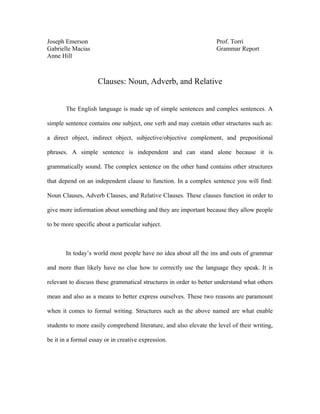
grammar project NRA clauses
- 1. Joseph Emerson Prof. Torri Gabrielle Macias Grammar Report Anne Hill Clauses: Noun, Adverb, and Relative The English language is made up of simple sentences and complex sentences. A simple sentence contains one subject, one verb and may contain other structures such as: a direct object, indirect object, subjective/objective complement, and prepositional phrases. A simple sentence is independent and can stand alone because it is grammatically sound. The complex sentence on the other hand contains other structures that depend on an independent clause to function. In a complex sentence you will find: Noun Clauses, Adverb Clauses, and Relative Clauses. These clauses function in order to give more information about something and they are important because they allow people to be more specific about a particular subject. In today’s world most people have no idea about all the ins and outs of grammar and more than likely have no clue how to correctly use the language they speak. It is relevant to discuss these grammatical structures in order to better understand what others mean and also as a means to better express ourselves. These two reasons are paramount when it comes to formal writing. Structures such as the above named are what enable students to more easily comprehend literature, and also elevate the level of their writing, be it in a formal essay or in creative expression.
- 2. The lesson plan that we have prepared aims to identify these complex structures, and explain them in some detail; moreover, we plan to simplify these concepts, making them easily recognizable and understandable. The lesson is intended to teach fellow English speakers (18+) more about the language they speak and how to use it properly. These concepts can be tricky and have tons of loop-holes where one thing may appear to be another. We will show the class how to distinguish among these structures and also how to diagram them. We have also prepared a few simple sayings that will make identifying and diagramming a piece of cake for even the newest grammar student. The Lesson Plan I. Introduction of all three topics II. Explain what purpose these structures have and what functions they perform. III. Explain each structure used in a sentence and diagram on the board. i. Noun Clauses ii. Adverb Clauses iii. Relative Clauses IV. Review concepts and functions with simple study helpers.
- 3. A Brief Description of the Clauses All clauses must contain a subject and a verb. To make it easier, forget about all the words that are used to introduce the clauses (this is recommended because attempting to decipher which clause you are dealing with based solely on the word it begins with will only prove to be confusing). Noun, Adverb and Relative clauses stick out in like a sore thumb in most cases; if one can identify the clause on sight alone defining the clause is simple, using these steps. Once the clause has been identified one must start by presuming it is a noun clause; replace the clause with “something” or “it”, if the sentence makes grammatical sense with this substitution it is in fact a noun clause, if it does not one must move on. Next, test for the Adverbial clause; to do this all one has to do is move the clause to the opposite end of the sentence from where it was. If the clause can be moved than it is an adverb clause, if one can not move it and maintain grammatical cohesion than there is only one conclusion; the clause is Relative. If one goes through these two simple steps, identifying which clause one is dealing with is fairly easy. Diagraming the sentence can be simplified also. Once the type of clause has been identified, diagraming will be a cinch. First, diagram the independent clause (if the dependent clause is a noun clause, one will need to diagram it on a pedestal somewhere within the independent clause’s diagram; note that a noun clause can function as a subject, subjective compliment, object of a preposition, direct object, indirect object, objective complement, or appositive). If the clause is either adverbial or relative it is diagrammed below the base line of the
- 4. independent clause. Here is an easy jingle to remember how to diagram each clause “Nouns go on pedestals, relatives shoot dotted bars and adverbs link verbs between each of the two clauses.” This saying will be more easily understood while we diagram on the board. Although Vitto does a great job defining each of these clauses on how to identify and diagram them, the vast amount of information can cloud the tasks overall simplicity. We decided to take the information and filter out the stuff that might confuse the class. The lesson we have prepared is sleek and easy; perfect.
- 5. Works Cited Vitto, Cindy L. “Complex Sentences with Noun Clauses & Complex Sentences with Adverb & Relative Clauses, & the Compound-Complex Sentence.” Grammar by Diagram: Understanding English Grammar through Traditional Sentence Diagraming. Peterborough, Ont.: Broadview, 2006. 132-164
- 6. Works Cited Vitto, Cindy L. “Complex Sentences with Noun Clauses & Complex Sentences with Adverb & Relative Clauses, & the Compound-Complex Sentence.” Grammar by Diagram: Understanding English Grammar through Traditional Sentence Diagraming. Peterborough, Ont.: Broadview, 2006. 132-164